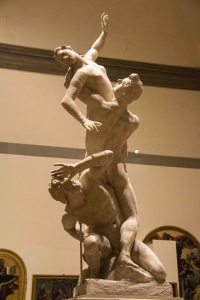 The tour of Tuscany was about culture, art, and a glimpse of Italian medieval history. During the middle ages a number of powerful city-states held sway over much of Italy. There was Venice, of course – which was not on our itinerary and not in Tuscany. But we would visit one of Venice’s and Rome’s greatest rivals – Florence, which flourished under the rule of the Medici family. We would also visit Lucca, Pisa, and Siena, which all vied for prominence for hundreds of years.
The tour of Tuscany was about culture, art, and a glimpse of Italian medieval history. During the middle ages a number of powerful city-states held sway over much of Italy. There was Venice, of course – which was not on our itinerary and not in Tuscany. But we would visit one of Venice’s and Rome’s greatest rivals – Florence, which flourished under the rule of the Medici family. We would also visit Lucca, Pisa, and Siena, which all vied for prominence for hundreds of years.
First cab off the rank was Firenze (Florence). Like all the other cities we visited, buses are off limits within a certain distance of the old city, so there’s always a fair bit of walking through narrow, cobbled streets.

Our first destination was the Galleria dell’Accademia, which was, and still is, an art school. We were going to see what is probably one of the most famous statues in the world, Michelangelo’s imposing statue of David, referred to by all our guides simply as “The David”. Our tour had organised tickets for us, which was just as well. Crowds of people waited outside and official-looking touts worked the crowd selling tickets at exorbitant prices. We had to start our tour at a particular time and we had to go through security such as you do at the airport (but not quite so stringent). Entry took longer than it should have. I wondered what people didn’t understand about not taking any metal objects through the gate. (I think it’s often because a lot of people don’t actually fucking listen when they’re given a briefing.)

Hey ho. Our local guide took us into the main chamber, where we admired a stunning ceiling. The we all gathered around what I thought was the famous statue, “The Rape of the Sabine Women”. I overheard somebody say, “Is that the David?” Ummm. Maybe the statue of David isn’t famous everywhere? But it wasn’t Giambologna’s marble masterpiece, either, which we did see in Florence’s main square. Sculptors usually created a mock-up of what the finished work was going to look like before they started on the marble. What we were looking at was that mock-up. Our guide made the point that Michelangelo never did mock-ups. He was very full of himself, trusting his skill with marble blocks that he usually selected himself. He and his contemporary, Leonardo da Vinci, did not get on.
We looked at a number of statues that had been started but never finished for various reasons, often because the patron changed his mind.
And then we reached The David. The statue is surrounded by a clear barrier so people can’t actually touch it. Apparently, some demented individual took to it with a hammer, damaging one foot, which explains the security to come into the gallery. It’s imposing, to say the least. Col noticed right away that the hands seemed too large. He was correct. The nearly 6m statue was supposed to have been displayed up high on the roofline of the Florence cathedral but that never happened. It stood outside the Palazzo Vecchio in the weather for more than 350 years before it was brought to the Accademia. A replica was placed in the square.

 Seeing it for real, it was the face (yes, really) that attracted me. There’s so much expression carved into the stone – or as Michelangelo would have said, released from the stone. He’s got a nice bum, too.
Seeing it for real, it was the face (yes, really) that attracted me. There’s so much expression carved into the stone – or as Michelangelo would have said, released from the stone. He’s got a nice bum, too.
We were able to take a quick look at some of the other exhibits, much of it religious art, before we moved on into the city to see the fabulous cathedral from the outside.



We had several hours of free time in Florence. We were told it wouldn’t be enough to get more than a cursory glance at anything in the Uffizi Gallery – and judging by the queues, that was right. There were queues to get into the cathedral, too. We wandered around the old city, ate lunch in a tiny café, then went down to the river to see the Ponte Vecchio.

There’s no way you can see Florence in a day. We got a glimpse, that is all. But we did get to see The David – in the flesh, as it were.
Leave a Reply